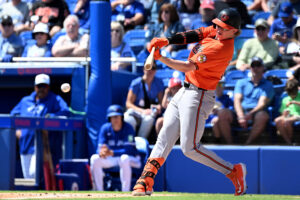Welcome to Week Nine of Ejection Inspection! The premise and ground rules are detailed here. The condensed version: each ejection from the previous week (Thursday through Wednesday) is listed in a table. The author – a former player/coach/umpire – analyzes each ejection and assigns it an entertainment rating of one to five Weavers in honor of late Orioles manager Earl Weaver. For the first time this season, a non-fight-related ejection has received Five Weavers. Congratulations to Milwaukee Brewers manager Craig Counsell for his tiff with Mike Estabrook!
(For a list of every article in this series, click here.)
There were nine ejections in Week Nine – four players and five managers – running the season total to 69. One manager was Seattle Mariners manager Scott Servais, whose ejection was the first of the season for the Mariners. Another was Cleveland Indians manager Terry Francona, whose ejection was the first of the season for the Indians. Now, 27 of the 30 teams have at least one. The only ones who still don’t have any yet are the Boston Red Sox, Tampa Bay Rays, and Texas Rangers.
| Date | Team | Opp | Inn. | Name | Pos | Umpire | Pos | Reason | ||
| 1 | Thu | 5/23 | WSN | @NYM | T8 | Howie Kendrick | 1B | Bruce Dreckman | HP | Arguing checked swing |
| 2 | Thu | 5/23 | WSN | @NYM | T8 | Dave Martinez | Mgr | Bruce Dreckman | HP | Arguing checked swing |
| 3 | Sat | 5/25 | CLE | TB | B6 | Terry Francona | Mgr | Eric Cooper | 3B | Arguing HBP/swing on bunt attempt |
| 4 | Sat | 5/25 | MIL | PHL | B4 | Ryan Braun | LF | Mike Estabrook | HP | Arguing balls/strikes |
| 5 | Sat | 5/25 | MIL | PHL | T9 | Craig Counsell | Mgr | Mike Estabrook | HP | Arguing balls/strikes |
| 6 | Sun | 5/26 | MIL | PHL | T7 | Mike Moustakas | 3B | Mike Estabrook | 3B | Arguing checked swing |
| 7 | Sun | 5/26 | SEA | @OAK | B7 | Scott Servais | Mgr | Chris Guccione | HP | Arguing slide interference replay call |
| 8 | Wed | 5/29 | CIN | PIT | B8 | David Bell | Mgr | Jeff Nelson | 3B | Anger at Nelson for “pointing at him” |
| 9 | Wed | 5/29 | KC | CWS | B2 | Glenn Sparkman | P | Mark Carlson | HP | Intentionally throwing at batter |
Howie Kendrick, Washington Nationals First Baseman
Dave Martinez, Washington Nationals Manager
When
Thursday, May 23, at New York Mets, top of the eighth
Umpire
Bruce Dreckman (HP)
Description
Trailing 3-1, Kendrick led off the top of the eighth. He tried to check his swing after starting to chase a 2-2 breaking ball low and away. Dreckman ruled that he swung and called him out. Kendrick immediately protested, wondering why Dreckman didn’t appeal to first. He finished his protest and walked to the dugout. After he had taken a few steps, Dreckman threw him out, prompting Martinez to emerge from the dugout. He had a lengthy discussion with Dreckman and was also tossed. After that, he kicked dirt, threw his hat, and followed Dreckman everywhere, continuing to yell at him for almost a minute before heading to the clubhouse.
Understand the frustration?
Yes. It makes no sense for an umpire to rule on a checked swing – even while feeling that it’s obvious – if there is an umpire at first or third. Why not remove doubt? Players and managers tend to get angrier when the plate umpire doesn’t appeal than they do if they disagree with the base umpire’s checked swing ruling.
Was the ejection justified?
Without knowing what Kendrick said, it feels like his was not, especially since Dreckman threw him out as he was walking away (while not yelling back over his shoulder). Martinez looked like he was going to stay on the field until he was ejected, so his was justified.
Entertainment Rating
One Weaver for Kendrick. Three Weavers for Martinez. Martinez looked like a four-year-old throwing a tantrum. He was trying too hard to make a scene. It looked manufactured or scripted.
Terry Francona, Cleveland Indians manager
When
Saturday, May 25, vs. Tampa Bay Rays, bottom of the sixth
Umpire
Eric Cooper (3B)
Description
Indians third baseman Jose Ramirez stepped to the plate in the bottom of the sixth facing a 3-1 deficit with designated hitter Carlos Santana on third. On 1-1, Ramirez attempted to bunt. He stabbed at the pitch and missed as it hit him in the left shin. On appeal, Cooper ruled it a strike. Francona came out of the dugout to argue. After a conversation that grew heated, Francona started using a lot of f-bombs and said something that starts with “horse” at least twice. At this point, Cooper gave him the heave-ho.
Understand the frustration?
Yes, even though the umpires were correct.
Was the ejection justified?
Yes. Francona had been given plenty of time to say his piece, and his language all but guaranteed an ejection.
Entertainment Rating
Two Weavers. Francona got slightly heated at the end, but that was it.
Mike Estabrook vs. the Milwaukee Brewers
A note before describing the next two ejections. Mike Estabrook’s strike zone in Saturday’s game between the Philadelphia Phillies and Milwaukee Brewers angered both teams. He was consistently calling strikes on pitches that were between six and twelve inches outside. While analyzing the video, this author discovered a mechanical issue.
Estabrook starts off setting up behind the inside corner while calling balls and strikes, which is exactly what umpires are taught to do. However, he’s supposed to stay there no matter where the catcher sets up. That is not what he did. All day long, if the catcher set up outside, Estabrook moved with him toward the outside corner, changing his view. When Estabrook stayed over the inside corner, his strike calls on the outside corner were fairly accurate. However, when following the catcher, he ended up calling strikes on pitches that were too far outside for the batters to realistically hit. This was a huge problem, and if this author noticed it, the league must have. If they did, Estabrook heard about it – guaranteed.
Back to the ejections…
Ryan Braun, Milwaukee Brewers Left Fielder
When
Saturday, May 25, vs. Philadelphia Phillies, bottom of the fourth
Umpire
Mike Estabrook (HP)
Description
Trailing 3-0 with one out and nobody on in the bottom of the fourth, Braun took an 0-1 pitch that looked to be a touch outside. Mike Estabrook called it a strike. Braun turned around and argued at length before continuing his at-bat. Two pitches later, Braun swung at and missed a breaking ball that was well out of the zone, making the second out of the inning. As he walked to the dugout, he said something over his shoulder. A couple of steps later, he looked back over his shoulder again and said something else, prompting the ejection.
Understand the frustration?
Yes, but it’s not like the pitch was waaaaaaaaaaaay outside. (That didn’t happen until later.) Braun needs to pick his battles better.
Was the ejection justified?
Yelling at the umpire over one’s shoulder while heading to the dugout will prompt an ejection almost every time, so yes. Braun should have shut his mouth after the first callback. He’s been in the league long enough to know this.
Entertainment Rating
Zero Weavers. This was very low-key, unlike the next one.
Craig Counsell, Milwaukee Brewers manager
When
Saturday, May 25, vs. Philadelphia Phillies, between the eighth and ninth
Umpire
Mike Estabrook (HP)
Description
In the bottom of the eighth, Mike Estabrook was still calling strikes on pitches that were well outside. After a leadoff single by first baseman Eric Thames, pinch hitter Jesus Aguilar took a 2-2 pitch for strike three even though it was between six and twelve inches outside. Shortstop Orlando Arcia then bounced a double down the line in left, bringing up second baseman Hernán Pérez, who plated Thames with a grounder to second for the second out. With the score now 4-2 and a runner on third, center fielder Lorenzo Cain stepped to the plate.
Cain took the first two pitches for balls. The third pitch was another six-to-twelve-inches-outside strike. The fourth pitch nearly hit Cain in the ankles, making the count 3-1. The next pitch was lower than ball two was, but Estabrook called it strike two, making the count full. Cain then grounded the 3-2 thigh-high fastball to the second baseman for the third out.
Between innings, Counsell told Estabrook from the dugout that he missed “five pitches” by “this much.” When saying “five,” he held up five fingers. When saying “this much,” he held his hands about a foot apart. Estabrook said something back to the dugout. Counsell said, “They’re not even close. They’re not even close.” Then Estabrook tossed him.
That was it for Counsell. He walked on the field and brought back memories of Weaver, Tommy Lasorda, and Bobby Cox combined. While approaching, he said, “You should see it! All you have to do is see. Your job is to see.” He arrived in front of Estabrook and continued, “You are missing pitches by so much, it’s crazy! It really is!” Now Counsell had his hands out and fingers spread. His eyes got as big as saucers. He and Estabrook said some things back and forth that weren’t audible and were tough to make out from lipreading.
Soon, they were chest-to-chest and jawing in each other’s face. Estabrook leaned in and put his forehead against the bill of Counsell’s hat as they let each other have it. Counsell yelled, “I’m looking at it. I’m telling you, you are missing, and you know that!” Estabrook hollered, “I don’t care what you are looking at!” Counsell said, “Oh, so you know that, huh?” Estabrook screamed, “I KNOW!” Counsell countered, “How do you know that? How? Oh YEAH? YOU KNOW?” Estabrook was yelling back over the top of Counsell, but his lips weren’t visible.
Then the camera caught him again. Counsell was saying, “You do not know!” while Estabrook was saying, “Yeah, I know!” Estabrook then leaned too far toward Counsell and knocked him backward with his chest. He claimed, “You’re bumping me! You bumped me!” as Third Base Umpire and Crew Chief Paul Emmel arrived to make peace. Emmel said, “Mike! Mike!” and then something that was unclear. Estabrook gave Counsell an arrogant glare and walked away. Emmel told Counsell, “Don’t follow him.” Then things died down.
Understand the frustration?
Big time. Yes, Estabrook was consistently calling that pitch, but the hitters couldn’t have hit those with a two-by-four or a boat oar. Had Cain walked like the Brewers felt he should have – we don’t know, since Arrieta probably would not have thrown the same pitch on 3-0 as he did on 2-1 – right fielder and reigning National League MVP Christian Yelich would have been at the plate as the go-ahead run. To make matters worse for Counsell, Estabrook had a pompous air about him. All that does is infuriate, which a good umpire should try to avoid.
Was the ejection justified?
What Estabrook said while Counsell was still in the dugout is unknown, so it’s hard to say. If he told him to stop, then, by the book, yes it was. However, seeing how Estabrook had been conducting himself all game, and seeing his body language during the discussion makes it seem like he was fanning flames instead of trying to defuse the situation, so the answer is going to have to be “probably not.”
Entertainment Rating
Five Weavers. Counsell may have read last week’s column, where his Four-Weaver ejection in Atlanta was dubbed “as mad as anyone will ever see Counsell get.” He rose to the challenge and topped it here. Not only did he set a new personal best, but this has been the Ejection of the Year so far. He got nose-to-nose with Estabrook, bugged his eyes out, and screamed in a back-and-forth. Earl Weaver himself would have applauded if he were in attendance. (He also might have come out of the stands after Counsell left the field and continued arguing where Counsell left off.)
One last thing – since Counsell was not suspended or fined by Major League Baseball, it is safe to assume that the league felt that Estabrook was in the wrong.
Mike Moustakas, Milwaukee Brewers Third Baseman
When
Sunday, May 26, vs. Philadelphia Phillies, top of the seventh
Umpire
Mike Estabrook (3B)
Description
Moustakas was called out by Mike Estabrook on an appealed check swing to end the sixth inning. During the first at-bat of the seventh, Moustakas tried to ask Estabrook about the swing. Estabrook said he wasn’t going to talk about it and warned Moustakas twice as Moustakas continued to ask his questions. Then Estabrook threw him out.
Understand the frustration?
Can’t really say it applies here. Moustakas didn’t seem frustrated at all until after Estabrook sent him packing. He simply seemed curious.
Was the ejection justified?
Estabrook warned Moustakas twice, so yes. Moustakas should have known better than to continue trying to talk to an umpire who told him twice to stop. (Especially that one.)
Having said that, this looked really bad. Since Moustakas never looked mad, Estabrook gave the appearance of an itchy trigger finger. It would probably be best for the league to keep him away from the Brewers for a while.
Entertainment Rating
Zero Weavers. It was low-key.
Scott Servais, Seattle Mariners manager
When
Sunday, May 26, at Oakland Athletics, bottom of the seventh
Umpire
Chris Guccione (HP)
Description
With nobody out in the bottom of the seventh and designated hitter Mark Canha on first, Athletics second baseman Jurickson Profar hit a grounder to first. Edwin Encarnacion fielded the ball and fired to second for the force. Shortstop J.P. Crawford stretched far to his right to catch the ball and tried to whip a return throw to first to complete the possible double play, but Canha’s slide tripped him, and he held the ball. Canha was out at second, but Profar was safe at first. Servais challenged the ruling of safe at first, claiming that Canha’s slide was illegal.
The slide did not look dirty, and Canha reached second with his arm. What made it questionable was that Canha appeared to trip Crawford intentionally in order to prevent a throw. Servais challenged the call on the field but lost. He then argued the replay decision and, by rule, was ejected.
Understand the frustration?
Absolutely. How can intentionally tripping a fielder to prevent a throw be considered a “bona fide slide?”
Was the ejection justified?
Since Servais argued a replay, he had to be ejected by rule, so yes.
Entertainment Rating
One Weaver, but keep in mind that Servais rarely gets heated.
David Bell, Cincinnati Reds manager
When
Wednesday, May 29, vs. Pittsburgh Pirates, bottom of the eighth
Umpire
Jeff Nelson (3B)
Description
With the Pirates leading 7-0, pitcher Clay Holmes hit Reds third baseman Eugenio Suarez on the hand with a fastball on the first pitch of the bottom of the eighth. He walked to the mound, asked if it was on purpose, was told no, and then walked to first. Bell came out of the dugout and demanded that Holmes be ejected. The umpires consulted one another then ruled that it wasn’t intentional.
Bell stayed on the field and persisted. Nelson explained the decision to Bell. While talking, Nelson talked with an open left hand – pinkie toward the ground, gently stabbing the air with each syllable. Bell then started yelling, “Get your finger out of my face,” prompting confusion from Nelson, whose hand was even with Bell’s chest. Then Bell told Nelson, “Get out of my face!” Bell then got angry, prompting first base umpire Laz Diaz to separate him and try to talk sense into him. Bell continued to scream at Nelson, so Nelson tossed him.
Understand the frustration?
It is understandable that the Reds would think that the plunking was intentional. However, after receiving the explanation, Bell’s antics were both confusing and downright annoying. Nelson was not pointing in his face, and he was certainly not even close to “being in Bell’s face.” Was Bell trying to get ejected on purpose?
Was the ejection justified?
Yes. Bell was being ridiculous.
Entertainment Rating
Zero Weavers and five eye rolls. This was the dumbest manager ejection of the season.
Glenn Sparkman, Kansas City Royals pitcher
When
Wednesday, May 29, at Chicago White Sox, bottom of the second
Umpire
Mark Carlson (HP)
Description
In the bottom of the second, with the Sox leading 2-1 and a runner on first, Sparkman hit shortstop Tim Anderson – whose celebration of a home run on April 17 sparked a retaliatory plunking and brawl between these teams – in the helmet with the second pitch. Carlson immediately dumped Sparkman, prompting vehement protests from Royals catcher Martin Maldonado and Royals manager Ned Yost.
Understand the frustration?
Yes, since it was the second inning and the pitcher threw a changeup.
Was the ejection justified?
On the surface, this was a quick trigger. However, it goes deeper than that. This was Tim Anderson’s first at-bat of the series – the first series between these teams since the brawl. For him to get hit in the head on the second pitch looked very bad. Was it intentional? Probably not, especially since Sparkman threw a changeup. However, from a game management standpoint, the ejection makes sense. Had Carlson not ejected Sparkman, how likely would it have been for the White Sox to retaliate?
Entertainment Rating
Zero Weavers. There was nothing memorable about this.
Leaderboard
After nine weeks, here are the leaders. Fight-related ejections are not counted toward the leaderboard.
Individual: Four-way tie – Chicago White Sox manager Rick Renteria, San Francisco Giants manager Bruce Bochy, Detroit Tigers manager Ron Gardenhire, and David Bell (three each)
Team (excluding fights): Cincinnati Reds (six)
Umpire (excluding fights): Mike Estabrook (six)
Look for Week Ten on Thursday, June 6th.
Evan Thompson played baseball as a youth and teenager. He also umpired between 1995 and 2004 and has coached at the high school level.
Main Photo
Embed from Getty Images






